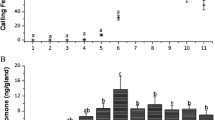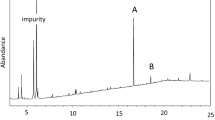Abstract
(Z)-10-Tetradecenyl acetate (Z10-14:OAc) from abdominal tip extracts of virgin females of the tentiform leafminer moth Phyllonorycter ulmifoliella (Lepidoptera: Gracillariidae) was identified by gas chromatography and mass spectrometry. The biological activity of the component was confirmed by field tests with synthetic compounds. As a sex pheromone component this ester is novel both in the family Gracillariidae and in the superfamily Gracillarioidea. Field trapping of P. ulmifoliella with synthetic Z10-14: OAc at dosages of 1 and 0.2 mg/dispenser led to catches of approximately 9000 and 3000 male moths, respectively. The attractivity of the Z10-14:OAc was strongly inhibited by a 10% admixture of either (Z)-9-tetradecenyl acetate (Z9-14:OAc), (E)-9-tetradecenyl acetate (E9-14:OAc), or (E)-11-tetradecenyl acetate (E11-14:OAc). Addition of 10% (E)-10-tetradecenyl acetate (E10-14:OAc) to the sex pheromone reduced attractivity, but significantly less than the inhibitors previously mentioned. The pheromone releasing (or “calling”) behavior of virgin P. ulmifoliella females was recorded under laboratory conditions. Calling activity started about half an hour before lightson and the maximum number of calling females was registered half an hour after the start of photophase. A high level of pheromone releasing activity lasted for about 2 hr and ceased about 5 hr after the start of photophase. Chemocommunication activity in the light period of day is assumed to be an adaptation which allows this phyllonoryctid to avoid inhibitors emitted as pheromones by many other species. A scheme of probable interactions by means of semiochemicals between P. ulmifoliella and other lepidopterans is presented and the appearance of Z10-14: OAc as a sex pheromone component in Lepidoptera during evolution of the order is discussed.
Similar content being viewed by others
REFERENCES
ANDO, T., YOSHIDA, S., TATSUKI, S., and TAKAHASHI, N. 1977. Sex attractants for male Lepidoptera. Agr. Biol. Chem. 41:1485–1492.
ARN, H., TÓTH, M., and PRIESNER, E. 1992. List of Sex Pheromones of Lepidoptera and Related Attractants, 2nd ed. Int. Organiz. Biol. Control, Montfavet.
ARN, H., TÓTH, M., and PRIESNER, E. 1993. Addenda to List of Sex Pheromones of Lepidoptera and related attractants, 2nd ed., Int. Organiz. Biol. Control, Montfavet.
BOOIJ, C. J. H., and VOERMAN, S. 1984. New sex attractants for 35 tortricid and four other lepidopterous species, found by systematic field screening in The Netherlands. J. Chem. Ecol. 10:135–144.
BŪDA, V. G., MOZŪRAITIS, R. L., and MERCHAITIS, V. P. 1991. Parthenogenesis and signalling behaviour of the moths Lithocolletis emberizaepennella Bouche (Lepidoptera, Gracillariidae). Doklady Biol. Sci. (Proc. Acad. Sci. USSR. Biol. Sci. Sector) 319:512–515 (English translation from Doklady AN SSSR).
FOSTER, S. P., and DUGDALE, J. S. 1988. A comparison of morphological and sex pheromone differences in some New Zealand Tortricinae moths. Biochem. Syst. Ecol. 16:227–232.
GRIES, G., MC BRIEN, H. L., GRIES, R., JIANXIONG, L., JUDD, G. J. R., SLESSOR, K. N. BORDEN, J. H., SMITH, R. F., CHRISTIE, M., TROUBRIDGE, J. T., WIMALARATNE, P. D. C. and UNDERHILL, E. W. 1993. (E4, E10)-dodecadienyl acetate: Novel sex pheromone component of tentiform leafminer, Phyllonorycter mespilella (Hubner) (Lepidoptera: Gracillariidae). J. Chem. Ecol. 19:1789–1798.
GUERIN, P. M., ARN, H., BUSER, H. R. CHARMILLOT, P., TOTH, M., and SZIRAKI, G. 1986. Sex pheromone of Grapholita funebrana. Occurrence of Z-8-and Z-10-tetradecenyl acetates as secondary components. J. Chem. Ecol. 12:1361–1368.
IVINSKIS, P, PAKALNISKIS, S., and PUPLESIS, R. 1985. Leafmining Insects. Mokslas. Vilnius (in Lithuanian).
KUZNETZOV, K. I. 1975. Tropic relationships between tentiform mining moths from subfamily Litchocolletinae (Lepidoptera, Litchocolletidae) and their host-plants in West Palaearctics. Otchetnaya nauchnaya sessya po itogam rabot 1974 goda. Tezisi dokladov. Nauka (Leningrad) pp. 13–14 (in Russian).
KUZNETZOV, K. I. 1979. A review of the genera of Gracillariidae (Lepidoptera) of the Palaearctic fauna. Entomol. Obozrenie LVIII:835–856 (in Russian).
LÖFSTEDT, C. 1993. Moth pheromone genetics and evolution. Phil. Trans. R. Soc. Lond. B 340(1292):167–177.
MEDVEDEV, G. S. 1981. Keys to the Insects of the European Part of the USSR, Vol. 4, Pt. 2 (in Russian).
NATKEVICAITE-IVANAUSKIENE, Ī. M. (ed.). 1976. Lithuanian Flora. Mokslas. Vilnius, Vol. 3 (in Lithuanian).
NIELSEN, E. S. 1989. Phylogeny of major lepidopteran groups, pp. 281–294, in K. Fernholm and H. Jörnvall (eds.). The Hierarchy of Life. (Proc. Nobel Symp. 70). Excerpta Medica, Amsterdam-New York-Oxford.
PHELAN, P. L. 1992. Evolution of sex pheromones and the role of asymmetric tracking, pp. 265–314, in B. D. Roitberg and M. B. Isman (eds.). Insect Chemical Ecology. An Evolutionary Approach. Chapman and Hall, New York.
ROBINSON, G. S. 1988. A phylogeny for the Tineoidae (Lepidoptera). Entomol. Scand. 19:117–129.
SCOBLE, M. J. 1992. The Lepidoptera. Form, Function and Diversity. Oxford University Press, Oxford.
SUGIE, H., TAMAKI, V., KAWASAKI, K., WAKOU, M., OKU, T., HIRANO, C., and HORIIKE, M. 1986. Sex pheromone of the apple leaf-miner moth, Phyllonorycter ringoniella (Matsumura) (Lepidoptera: Gracillariidae): Activity of geometrical isomers of tetradecadienyl acetates. Appl. Entomol. Zool. 21(4):578–581.
TÓTH, M., SZÖCS, G., VAN NIEUKERKEN, E. J., PHILIPP, P., SCHMIDT, F., and FRANCKE, W. 1995. Novel type of sex pheromone structure identified from Stigmella malella (Stainton) (Lepidoptera: Nepticulidae). J. Chem. Ecol. 21(1):13–27.
WITZGALL, P. P., FREROT, B., and MALOSE, C. 1991. Identification de compose majoritaire de la secretion pheromonale de Notocelia uddmanniana (Lep., Tortricidae). J. Appl. Entomol. 112:71–75.
ZHU, J., KOZLOV, M. V., PHILIPP, P., FRANCKE, W., and LÖFSTEDT, C. 1995. Identification of a novel moth sex pheromone in Eriocrania cicatricella (Zett.) (Lepidoptera: Eriocraniidae). J. Chem. Ecol. 21(1):29–43.
Author information
Authors and Affiliations
Rights and permissions
About this article
Cite this article
Mozūraitis, R., Būda, V., Borg-Karlson, AK. et al. Chemocommunication in Phyllonorycter ulmifoliella (HBN.) (Lepidoptera: Gracillariidae): Periodicity, Sex Pheromone, and Inhibitors. J Chem Ecol 23, 175–189 (1997). https://doi.org/10.1023/B:JOEC.0000006353.51462.37
Issue Date:
DOI: https://doi.org/10.1023/B:JOEC.0000006353.51462.37




